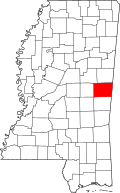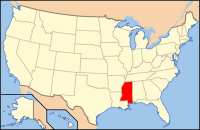Kemper County, MS
| Kemper County, Mississippi | |
|---|---|
 Location in the U.S. state of Mississippi |
|
 Mississippi's location in the U.S. |
|
| Founded | 1833 |
| Named for | Reuben Kemper |
| Seat | De Kalb |
| Largest Town | De Kalb |
| Area | |
| • Total | 767 sq mi (1,987 km2) |
| • Land | 766 sq mi (1,984 km2) |
| • Water | 0.8 sq mi (2 km2), 0.1% |
| Population | |
| • (2010) | 10,456 |
| • Density | 14/sq mi (5/km²) |
| Congressional district | 3rd |
| Time zone | Central: UTC-6/-5 |
Kemper County is a county located in the U.S. state of Mississippi. As of the 2010 census, the population was 10,456. Its county seat is De Kalb. The county is named in honor of Reuben Kemper.
The county is part of the Meridian, MS Micropolitan Statistical Area. In 2010 the Mississippi Public Service Commission approved construction of the Kemper Project, designed to use "clean coal" to produce electricity for 23 counties in eastern part of the state. As of February 2017, it was not completed and had cost overruns. It is designed as a model project to use gasification and carbon-capture technologies at this scale.
United States Senator John C. Stennis, who served from 1947 to 1988, was born in Kemper County. Another Kemper County native was Texas Ranger Captain Bill McDonald.
East Mississippi Community College is located in Kemper County in the town of Scooba, at the junction of US 45 and Mississippi Highway 16.
In this county the land was developed by white planters for cotton cultivation in the 19th century. It continues to be largely rural. After the American Civil War and Reconstruction, racial violence increased as whites struggled to regain power over the majority population of freedmen. In the period from 1877 to 1950, Kemper County had 21 documented lynchings of African Americans, second only to Hinds County as the highest total in the state. This form of racial terrorism was at its height in the decades at the turn of the 20th century, which followed the state's disenfranchisement of most blacks in 1890 through creating barriers to voter registration. In 1890, blacks made up the majority of the county' population: 10,084 blacks to 7,845 whites.
...
Wikipedia
